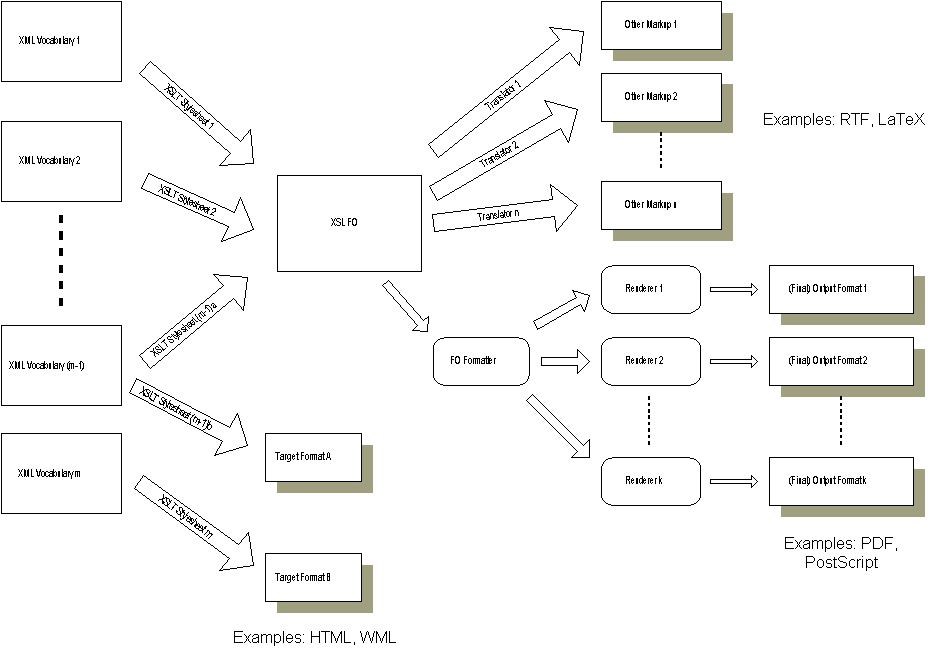- From: Arved Sandstrom <asandstrom@accesscable.net>
- Date: Sun, 4 Feb 2001 11:22:01 -0400
- To: <www-xsl-fo@w3.org>
- Message-ID: <005e01c08ebe$3c6d4b60$089e4718@accesscable.net>
Note: this was undoubtedly meant for the list, but got sent to me only because of the Reply-To thing. Hi, Dave My meaning of "interchange format" is an implementation-centric meaning. That is, I do not anticipate that users will ever look at an interchange format. I think any file format becomes an interchange format if it exhibits the quality of being an accepted medium of exchange. The situation is analogous to a language translation problem: given 50 inputs (different languages) and 50 outputs (other languages), the options are to prepare each of the 2500 translation dictionaries, or prepare 100 dictionaries - 50 for translation to English, and 50 for translation from English. MS Word has become such a format, whether we like it or not. I am not (repeat not) proselytizing on behalf of FO as an interchange format, although I am not against it either in the context of formatting.The reason I think it is a worthwhile subject for debate is because I see formats suggested as things that should come out of a FO formatter+renderer combination, that should actually either be inputs, or not be exposed to FO formatting at all (HTML out of FO? What's the point?) If FO is to be used at all, let us use it rationally. I have prepared a diagram which exhibits my Weltanschauung of an ideal system. It is attached. Regards, Arved ----- Original Message ----- From: Dave Pawson <daveP@dpawson.freeserve.co.uk> To: Arved Sandstrom <asandstrom@accesscable.net> Sent: Wednesday, January 31, 2001 2:18 PM Subject: Re: Renderers and XSL-FO, plus other thoughts... > At 10:39 AM 1/31/01, Arved Sandstrom wrote: > > >I wasn't aware of this particular WAI-driven clause. I'll have to check it > >out. > > > >Why was WAI so against FO as "interchange"? Because in scenarios that I can > >envisage, I still wouldn't expect to be visually inspecting FO. And how is > >the current situation better, where a visually-impaired person has to still > >deal with putting FO inside XSLT templates? > > If you look at that as a case of 'using' a stylesheet (fo or other) > to 'read' an XML document, does that make sense? > Sighted readers might prefer fo ->pdf > Low vision might want same, but with 30 point print. > A blind user would want (maybe) braille/audio output. > Simply a case of give a reader the choice? > > > AS. > >I'm not sure that _this_ issue is a "user" issue. This has more to do with > >implementations. From the viewpoint of elegance I just object to taking FO > >(which in theory I could convert to RTF better at that point), running a > >processor on it, then running a renderer on the output to produce RTF, which > >will probably have considerably more translation work to do at that point > >because the levels of abstraction are different. > > I think its a user perspective. MY guess, your view, as implementor, > is quite markedly different from a user view? > > > > > > >The user would see a "print-quality output preparation system" based on XML. > >You're right, they wouldn't care, nor should they. Adding to the first > >point, in this view FO as an interchange format would also be internal to > >the "printing system". > > Perhaps we differ in terms of understanding? Would you define interchage > format please? Between who and whom? > > > > > >Right, I think we would have to be talking about CSS3 to make this > >realistic. We're still talking (IMHO) about printing here, mainly > >(high-quality output); let Web browsers deal with HTML... > > > don't forget that CSS3 has a good auditory capability? > > Regards DaveP > > > >
Attachments
- image/gif attachment: InterchangeFO.gif

Received on Sunday, 4 February 2001 10:27:17 UTC